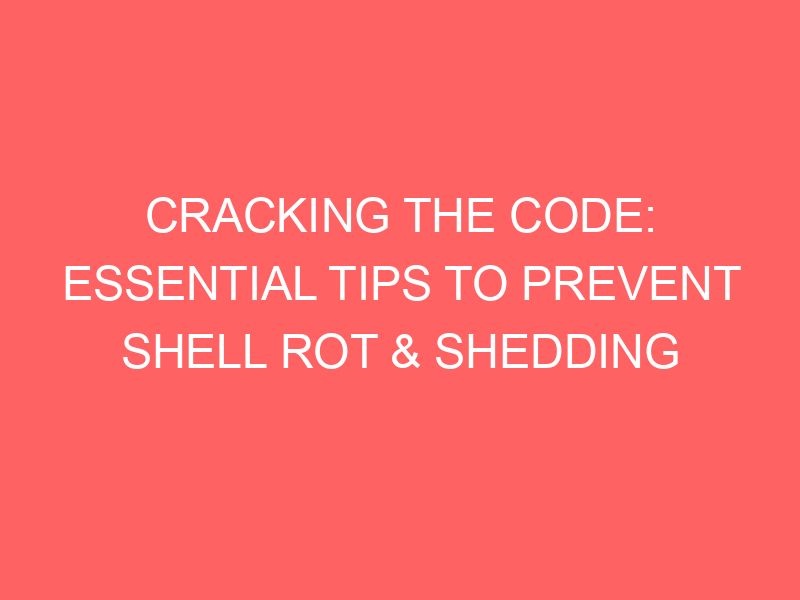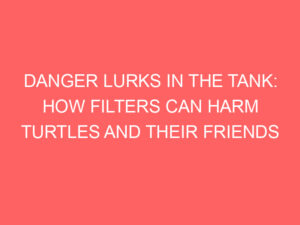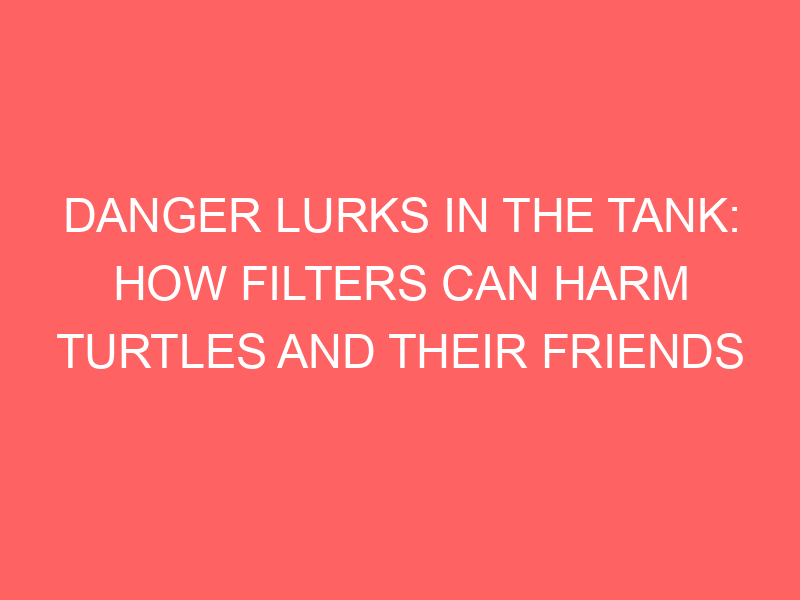
Introduction to Shell Care 101
Welcome to Shell Care 101, a comprehensive guide designed to help you understand and take care of your turtle’s shell health. This guide will provide you with valuable insights into the importance of shell health maintenance and common shell issues in turtles.
- Importance of Shell Health Maintenance
- Common Shell Issues in Turtles
Just like humans need to take care of their skin, turtles need proper shell care. The shell is a vital part of a turtle’s body, serving as a protective shield against predators and environmental hazards. It is made up of bones and keratin, the same protein found in human nails and hair. Poor shell health can lead to various issues, including infections and diseases, which can significantly affect a turtle’s lifespan. Therefore, regular shell health maintenance is crucial for a turtle’s overall well-being.
Turtles can encounter several shell-related problems. Two of the most common issues are shell rot and shell shedding. Shell rot is a fungal or bacterial infection that causes the shell to decay, leading to discomfort and potential health risks. On the other hand, shell shedding is a natural process where turtles shed old layers of their shell to make way for new growth. However, abnormal or excessive shedding can indicate health problems. In the following sections, we will delve deeper into these issues and provide you with practical tips on how to prevent them.
Understanding and addressing shell health issues is an essential part of turtle care. By learning about these issues and how to prevent them, you can ensure that your turtle lives a long, healthy, and happy life. So, let’s dive into Shell Care 101 and start our journey towards becoming responsible turtle owners.
Understanding Shell Rot
Shell rot is a common health issue that can affect turtles and tortoises. It’s a serious condition that requires immediate attention. Let’s delve into understanding the causes of shell rot.
Shell Rot Causes
There are several factors that can lead to shell rot in turtles and tortoises. Here are the most common causes:
- Unhygienic living conditions: Just like humans, turtles and tortoises need a clean environment to stay healthy. When they live in dirty conditions, harmful bacteria can grow and cause infections like shell rot. For example, a turtle living in a tank with dirty water is more likely to get shell rot.
- Poor diet: Turtles and tortoises need a balanced diet to keep their shells strong and healthy. If they don’t get the right nutrients, their shells can weaken and become more susceptible to infections. For instance, a diet lacking in calcium can lead to a soft shell, making it easier for bacteria to penetrate and cause shell rot.
- Physical injury: Any injury to the shell, like a crack or a scratch, can be an entry point for bacteria. Once inside, these bacteria can cause an infection that leads to shell rot. Even a small injury can be dangerous if it’s not treated properly.
Understanding the causes of shell rot is the first step in preventing this condition. In the next sections, we will discuss the symptoms of shell rot and how to treat it.
Identifying Shell Rot Symptoms
Shell rot is a serious condition that can affect the health of your pet. It’s crucial to recognize the symptoms early to ensure prompt treatment. Here are the most common symptoms of shell rot:
- Discoloration of the Shell
- Foul Smell
- Softening of the Shell
The first sign of shell rot is often a change in the color of your pet’s shell. Healthy shells are typically vibrant and glossy. If you notice dullness, dark spots, or unusual color changes, it could be an indication of shell rot.
A healthy shell should not have a strong odor. If you detect a foul or unusual smell coming from your pet’s shell, it’s a clear sign of an infection. This smell is often caused by bacteria or fungus, which are the primary causes of shell rot.
A healthy shell should be hard and robust. If the shell feels soft to the touch or appears to be deteriorating, it’s a serious symptom of shell rot. This softening is due to the decay of the shell’s material, which is caused by the disease.
Remember, early detection of these symptoms can make a huge difference in your pet’s health. If you notice any of these signs, it’s essential to seek professional veterinary care immediately.
Shell Rot Treatment
When it comes to treating shell rot, there are two main approaches. One involves professional veterinary care, while the other involves home remedies. Both methods have their own effectiveness and should be chosen based on the severity of the condition.
- Professional Veterinary Care
Professional veterinary care is the most reliable and effective method for treating shell rot. A qualified vet will be able to accurately diagnose the condition and prescribe the appropriate treatment. This may involve cleaning the infected area, applying topical antibiotics, and in severe cases, surgical debridement. Regular follow-up visits will also be necessary to monitor the healing process.
According to a study, professional veterinary care has a success rate of over 90% in treating shell rot. This is because vets have access to advanced medical equipment and drugs that are not available for home use. Therefore, if your pet is suffering from severe shell rot, it is highly recommended to seek professional help.
- Home Remedies and Their Effectiveness
Home remedies can also be effective in treating mild cases of shell rot. These remedies usually involve cleaning the shell with a mild antiseptic solution and applying a topical ointment. However, it’s important to note that home remedies should only be used as a first aid measure or for mild cases. For severe cases, professional veterinary care is still the best option.
Research shows that home remedies can be effective in treating mild shell rot, with a success rate of around 70%. However, the effectiveness of home remedies largely depends on the correct application and consistency of treatment. Therefore, it’s crucial to follow the instructions carefully and monitor the condition closely.
In conclusion, both professional veterinary care and home remedies can be effective in treating shell rot. However, the choice between the two should be based on the severity of the condition and the resources available. Remember, the health and well-being of your pet should always be your top priority.
Preventing Shell Rot
Shell rot is a common issue that affects many types of shelled animals, such as turtles and tortoises. It’s a serious condition that can lead to severe health problems if not treated promptly. However, with proper care and attention, shell rot can be prevented. Let’s explore some effective shell care tips.
Shell Care Tips
Shell care is not as complicated as it might seem. It involves three key aspects: regular cleaning, a proper diet, and appropriate habitat conditions. By following these tips, you can help prevent shell rot and ensure your pet’s shell remains healthy.
- Regular Cleaning
- Proper Diet
- Appropriate Habitat Conditions
Regular cleaning is crucial for preventing shell rot. It involves gently scrubbing the shell with a soft toothbrush and warm water to remove any dirt or algae. This process should be done at least once a week. Remember, never use harsh chemicals or soaps as they can damage the shell and harm your pet.
A balanced diet is essential for shell health. Foods rich in calcium and vitamin D, such as leafy greens and cuttlebone, help to strengthen the shell. Avoid feeding your pet a diet high in protein, as this can lead to rapid growth and shell deformities.
The right habitat conditions play a significant role in preventing shell rot. Ensure your pet’s habitat has the correct temperature and humidity levels. A dry environment can lead to shell cracking, while a too damp environment can encourage fungal growth. Both conditions can lead to shell rot.
In conclusion, preventing shell rot is all about providing the right care for your pet. Regular cleaning, a proper diet, and appropriate habitat conditions are key to maintaining a healthy shell. By following these tips, you can help ensure your pet’s shell remains strong and healthy.
Understanding Shell Shedding
Shell shedding is a natural and essential part of a turtle’s life. It’s a sign of healthy growth and development. Let’s delve deeper into this fascinating process.
Shell Shedding Process
The shell shedding process is a part of the normal growth process in turtles. It’s not something to be alarmed about, but rather a sign of a healthy, growing turtle. Let’s break down this process into two key areas.
- Normal growth process in turtles
- How to identify healthy shedding
Turtles, like other reptiles, shed their skin. However, unlike snakes that shed their skin in one piece, turtles shed their skin in small patches. The same applies to their shells. As turtles grow, their shells grow too. The old, outer layer of the shell peels off, making way for the new, larger shell underneath. This is a slow and gradual process that happens over several weeks or even months. It’s a clear sign that your turtle is growing and developing as it should.
Healthy shell shedding is a gradual process. You might notice small, thin pieces of the shell coming off. These pieces are often translucent or white. The new shell underneath should look healthy and vibrant. There should be no signs of discoloration, foul smell, or soft spots. These could be signs of shell rot, which is a serious health issue. Healthy shedding should not cause your turtle any discomfort or change in behavior. If your turtle seems distressed or its behavior changes, it’s best to consult a vet.
Understanding the shell shedding process is crucial for every turtle owner. It helps you monitor your pet’s growth and ensure its shell remains healthy. Remember, a healthy shell is a sign of a healthy turtle.
When Shell Shedding Becomes a Problem
While shell shedding is a normal part of a turtle’s growth process, there are instances when it can become a problem. It’s crucial to understand the signs of abnormal shedding and know what to do if your turtle is experiencing difficulties.
- Signs of abnormal shedding
- Large pieces of shell coming off at once
- Shedding happening too frequently
- Presence of redness, swelling, or open sores
- Shell appearing dull or discolored
- What to do when shedding becomes a problem
- Consult a vet: If your turtle’s shell appears unhealthy, it’s best to consult a vet immediately. They can provide a proper diagnosis and treatment plan.
- Adjust the environment: Ensure your turtle’s habitat is clean, well-maintained, and has the right temperature and humidity levels.
- Review diet: A balanced diet is crucial for a turtle’s overall health, including its shell. Make sure your turtle is getting the right nutrients.
Abnormal shedding can manifest in various ways. Here are some signs to look out for:
If you notice any of these signs, it’s essential to take immediate action to prevent further complications.
If you suspect your turtle is having trouble with shedding, here are some steps you can take:
Remember, prevention is always better than cure. Regular check-ups and proper care can help keep your turtle’s shell healthy and prevent shedding problems.
Shell Shedding Prevention
Preventing shell shedding in turtles is a crucial aspect of their overall health. This process is natural and healthy, but sometimes, it can lead to complications if not properly managed. Let’s delve into some of the ways you can ensure your turtle’s shell remains in top condition.
Turtle Shell Care
There are three key aspects to consider when it comes to turtle shell care: UVB lighting, proper nutrition, and regular check-ups. Let’s explore each of these in detail.
- Importance of UVB lighting
- Proper nutrition
- Regular check-ups
UVB lighting is essential for turtles. It helps them synthesize vitamin D3, which is necessary for the absorption of calcium. Calcium, in turn, is vital for a healthy shell. Without adequate UVB light, turtles can develop metabolic bone disease, which can lead to shell deformities and shedding. Therefore, ensure your turtle’s habitat has a UVB light source that’s on for about 10-12 hours a day.
A balanced diet is key to preventing shell shedding. Turtles need a mix of proteins, fruits, vegetables, and calcium supplements to maintain a healthy shell. Foods rich in vitamin A, like carrots and sweet potatoes, can help improve shell health. Avoid overfeeding your turtle as obesity can lead to shell problems.
Regular veterinary check-ups are vital in detecting early signs of shell problems. A vet can examine your turtle’s shell for any signs of shedding, rot, or other issues. They can also provide advice on diet and habitat changes to prevent shell shedding.
In conclusion, preventing shell shedding in turtles involves a combination of proper lighting, nutrition, and regular veterinary care. By following these steps, you can ensure your turtle’s shell remains healthy and strong.
Conclusion: Shell Health 101
As we wrap up our discussion on shell health, it’s essential to remember the key points we’ve covered. Shell health is crucial for the overall well-being of your pet, and it’s something every pet owner should prioritize.
- Recap of shell care tips
- Importance of early detection and prevention
Firstly, we discussed the importance of regular shell care. This includes cleaning the shell with a soft brush and mild soap, providing a balanced diet rich in calcium for shell strength, and ensuring your pet has access to natural sunlight or UVB light for vitamin D synthesis. We also touched on the importance of a proper habitat with the right temperature and humidity levels.
Secondly, we emphasized the importance of early detection and prevention of shell health issues. Regularly inspecting your pet’s shell for signs of shell rot or abnormal shedding can help catch any problems early. Remember, prevention is always better than cure. Regular vet check-ups are also recommended for professional assessment of your pet’s shell health.
In conclusion, shell health is a vital aspect of your pet’s overall well-being. By following the tips we’ve discussed, you can ensure your pet lives a healthy and happy life. Remember, a healthy shell is a sign of a healthy pet.














